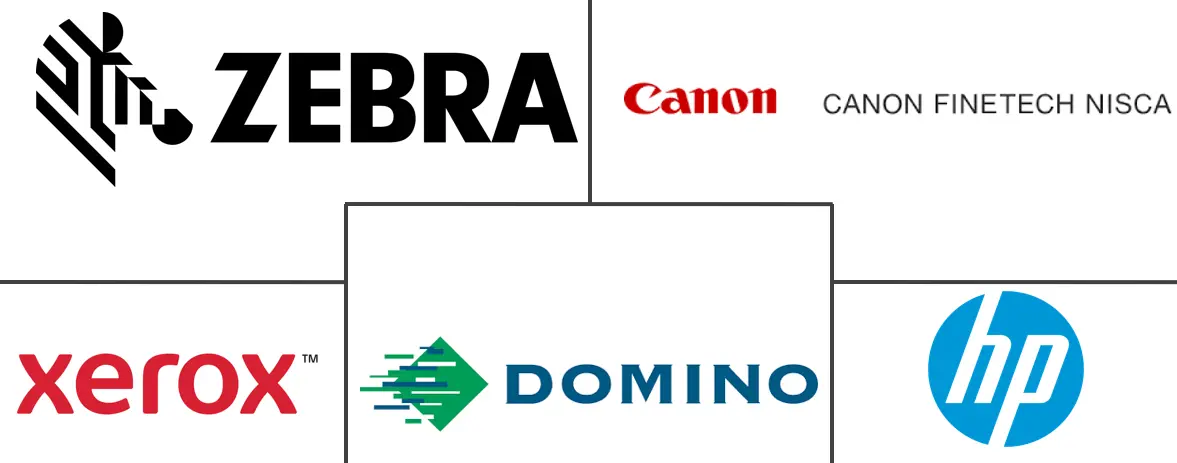Microprinting Market Size and Share
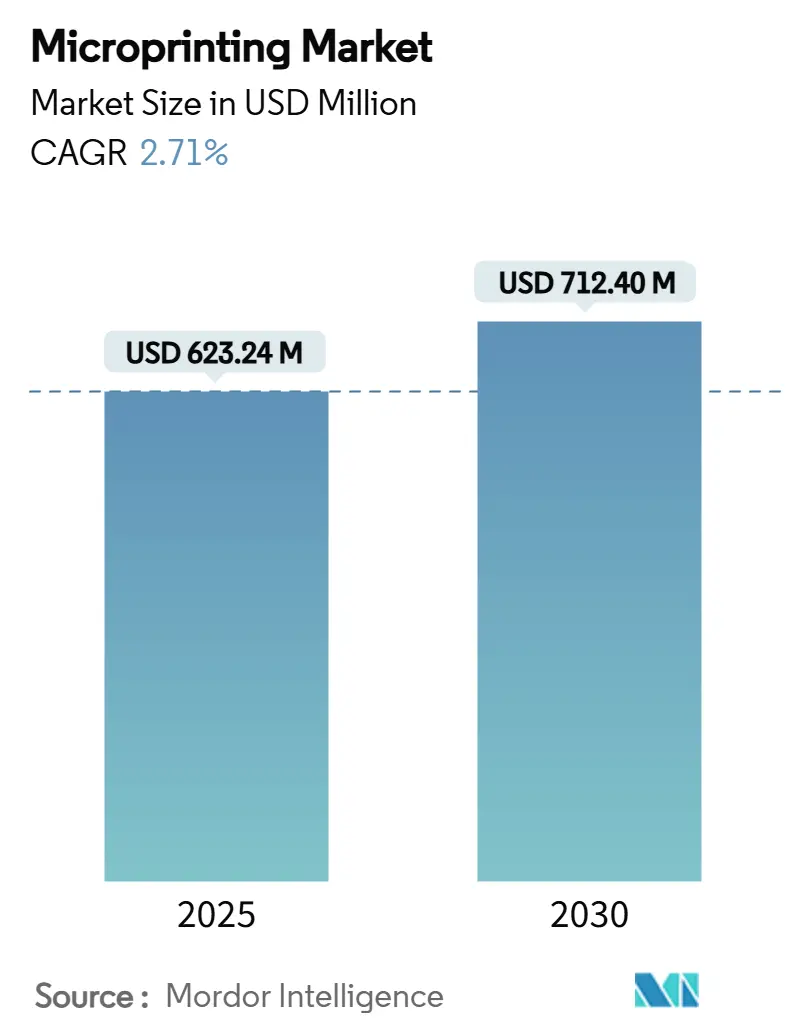
Microprinting Market Analysis by Mordor Intelligence
The microprinting market size stands at USD 623.24 million in 2025 and is forecast to reach USD 712.40 million by 2030, translating to a compound annual growth rate (CAGR) of 2.71%. Heightened regulatory focus on document security in banking, pharmaceuticals, and government identification keeps demand resilient even as digital transactions grow. Expansion continues as nanoparticle-enhanced inks, blockchain-linked authentication, and high-resolution modular presses unlock fresh revenue opportunities. Environmental mandates are reshaping ink chemistry, yet compliance investments are balanced by stronger customer preference for tamper-proof packaging and identity credentials. Competitive intensity rises as traditional press suppliers partner with or acquire security-technology firms to deepen portfolios while specialized vendors push 1,200 dpi hybrid engines that cut change-over times and enable variable data printing at scale.
Key Report Takeaways
- By type, color microprinting led with 62.6% revenue share in 2024; monochrome is projected to expand at a 4.20% CAGR through 2030.
- By print type, single-sided held 54.9% of the microprinting market share in 2024, whereas double-sided systems are forecast to post a 3.40% CAGR by 2030.
- By substrate, paper accounted for 67.2% of the microprinting market size in 2024; plastic is set to grow at 2.9% CAGR to 2030.
- By application, the BFSI segment commanded 37.1% share of the microprinting market in 2024, while pharmaceutical packaging is advancing at a 4.1% CAGR through 2030.
- By geography, North America dominated with 35.3% share in 2024; Asia-Pacific is the fastest-growing region with a 3.8% CAGR to 2030.
Global Microprinting Market Trends and Insights
Drivers Impact Analysis
| Driver | (~) % Impact on CAGR Forecast | Geographic Relevance | Impact Timeline |
|---|---|---|---|
| Escalating demand for anti-counterfeit document security | +0.8% | Global, with concentration in North America and EU | Medium term (2-4 years) |
| Stricter pharma serialization and packaging mandates | +0.6% | Global, led by US DSCSA and EU FMD requirements | Short term (≤ 2 years) |
| Rapid MICR adoption in banking cheque processing | +0.4% | North America and Asia-Pacific core markets | Long term (≥ 4 years) |
| Surge in e-passport and national-ID roll-outs | +0.5% | Asia-Pacific core, spill-over to MEA and Latin America | Medium term (2-4 years) |
| Nanoparticle functional inks enabling ultra-durable microtext | +0.3% | Global, with early adoption in developed markets | Long term (≥ 4 years) |
| Blockchain-linked on-pack microtext for consumer authentication | +0.2% | Global, with pilot programs in premium brands | Long term (≥ 4 years) |
| Source: Mordor Intelligence | |||
Escalating Demand for Anti-Counterfeit Document Security
Governments and corporations face sophisticated forgery methods, prompting wider adoption of micro-scale security marks in currency, licences, and brand certificates. The U.S. Department of Homeland Security released guidelines that retrofit high-end presses to embed 0.5-point microtext, maintaining production speed while raising forgery deterrence.[1]U.S. Department of Homeland Security, “Counterfeit Deterrence Paper,” dhs.gov New Jersey regulations now require prescriptions to carry microtext legible only at 500% magnification, a measure aimed at cutting USD 100 billion lost annually to fake scripts. Financial institutions further integrate magnetic ink with biometric checks to form multilayer defences.
Stricter Pharma Serialization and Packaging Mandates
The U.S. Drug Supply Chain Security Act obliges every prescription unit to bear unique, machine-readable serials, creating sustained demand for high-resolution inline coders.[2] U.S. Food & Drug Administration, “Drug Supply Chain Security Act (DSCSA),” fda.gov UPM Pharmaceuticals demonstrated real-time tracking that trims recall time from days to hours. In Europe, the Falsified Medicines Directive accelerates line upgrades as firms add microprinted batch data, expiry dates and QR codes. Partnerships such as Siegfried-TraceLink provide scale-out cloud traceability that dovetails with on-pack microtext.
Rapid MICR Adoption in Banking Cheque Processing
Magnetic-ink character recognition retains relevance as a fraud-mitigation tool that electronic alternatives cannot fully match. Bank of Baroda rolled out MICR clearing across its India network, lifting processing speed while keeping error rates below 0.02%.[3]Bank of Baroda, “MICR Clearing Rollout,” bankofbaroda.in Check 21 statutes in the United States further protect the legal standing of MICR-encoded cheques, sustaining equipment investment cycles. Emerging markets combine MICR with biometric approval to strengthen identity assurance.
Surge in E-Passport and National-ID Roll-Outs
India’s Passport Seva 2.0 deploys RFID-enabled passports with multilayer microtext, opening a USD 1 billion procurement pipeline. Costa Rica’s biometric e-passport reached 68,000 issuances within three months, indicating rapid citizen adoption. Nepal’s multi-layer personalization integrates color photos and embedded chips compliant with ICAO standards. Governments balance fee cuts with upgraded security, broadening the addressable microprinting market.
Restraints Impact Analysis
| Restraint | % Impact on CAGR Forecast | Geographic Relevance | Impact Timeline |
|---|---|---|---|
| High capex for less than 10 µm resolution press lines | -0.4% | Global, particularly impacting SMEs | Short term (≤ 2 years) |
| Digitisation reducing paper-based transactions | -0.3% | Developed markets, led by North America and EU | Medium term (2-4 years) |
| Vision-system readability rejects for ultra-fine text | -0.2% | Global manufacturing hubs | Short term (≤ 2 years) |
| Environmental limits on heavy-metal and nano-pigment inks | -0.3% | EU-led, expanding globally | Medium term (2-4 years) |
| Source: Mordor Intelligence | |||
High Capex for Less than 10 µm Resolution Press Lines
Installing sub-10 µm platforms demands multi-million-dollar outlays and specialist operators. Heidelberger Druckmaschinen targets 8% EBITDA by streamlining spend on such assets while still meeting security-print tolerances. HP’s supply-chain relocation outside China adds tariff-related cost layers that small converters find difficult to absorb. The capital hurdle delays entry by SMEs even as regulatory bars rise.
Environmental Limits on Heavy-Metal and Nano-Pigment Inks
France’s 2025 mineral-oil ban forces ink reformulation, requiring validated test methods published by the European Printing Ink Association. U.S. EPA SNUR filings oblige manufacturers to pre-clear new chemistries, extending development cycles. Orion S.A. responded with bio-circular PRINTEX Nature 35, proving performance parity for secure graphics without restricted oils. Early adopters of compliant inks gain first-mover advantage in regulated tenders.
Segment Analysis
By Type: Color Dominance Drives Premium Applications
Color microprinting generated the largest revenue share at 62.6% in 2024 as users valued multi-layer chromatic effects that complicate counterfeiting attempts. The segment integrates optically variable inks and quantum-dot tags that produce triple-level encryption, thereby cementing its hold on high-value documents. Monochrome retains a niche, yet nanoparticle black inks make it attractive for cheque and label lines that rely on legacy presses. Research groups now embed gold or silver nanoparticles into transparent varnishes, enabling covert watermarks within either segment. Color advances such as fluorescence-lifetime coding extend security by adding time-based verification.
Growing cost sensitivity keeps monochrome in focus, especially for institutions upgrading in phases. Nano-ink blends lower viscosity, permitting retrofits without overhauling print heads and supporting a 4.20% CAGR to 2030. Hybrid workflows let converters switch between monochrome base layouts and targeted color micro-text overlays, optimizing ink spend while preserving traceability. Vendors that offer drop-in fluids compliant with sub-10 µm nozzles win share as converters aim for minimal downtime. The dual-track evolution suggests the Microprinting market will continue blending vivid overt features with covert monochrome data at line speeds suited to mass issuance.

By Print Type: Single-Sided Solutions Meet Efficiency Demands
Single-sided configurations accounted for 54.9% of the Microprinting market in 2024 thanks to simpler web paths and shorter make-ready times. Banks, pharmacies and licensing bodies often need authentication on only one face of cheques, blister packs or permits, aligning well with single-pass engines. Low substrate waste and the ability to retrofit onto existing offset lines further support dominance. However, brand-protection programmes in luxury goods and passports now require microsecurity coverage on both surfaces, lifting double-sided solutions at a robust 3.40% CAGR.
Xerox’s Beyond Secure platform demonstrates in-line duplex capability without special paper, meeting customer demand for full-bleed variable data while trimming process steps. Double-sided systems also accommodate tamper-evident VOID patterns that appear when either side is altered, increasing deterrence. As algorithms detect microspacing irregularities, duplex lines can issue near-real-time reject signals, preventing downstream packaging jams. Therefore, equipment suppliers focusing on modular upgrades that convert single-sided assets into duplex will capture expansion spend while retaining the install base.
By Substrate: Paper Foundation Supports Digital Transition
Paper retained 67.2% of microprinting market share in 2024, anchored by its entrenched use in cheques, certificates and unit-dose pharma cartons. Regulatory familiarity and compatibility with high-volume flexographic presses keep adoption high even as electronic workflows advance. Paper also enables chemically reactive inks that reveal colour shifts under specific solvents, adding covert security. Plastic substrates, however, satisfy durability needs for ID cards, fare media and warehouse labels, growing 2.9% CAGR through 2030.
Suppliers such as Telesis Technologies use laser-etch stations to micro-mark plastic medical parts, guaranteeing permanence under sterilisation. Metals serve micro-trace codes in aerospace and defence where tamper-proof compliance certificates are mandatory. Smart substrates embedding mechano-chromic photonic crystals present long-term avenues by providing reversible colour shifts when bent, offering dynamic authenticity checks at point of use. The interplay of legacy paper and engineered plastics ensures the Microprinting market remains rooted in proven materials while diversifying into high-performance films.
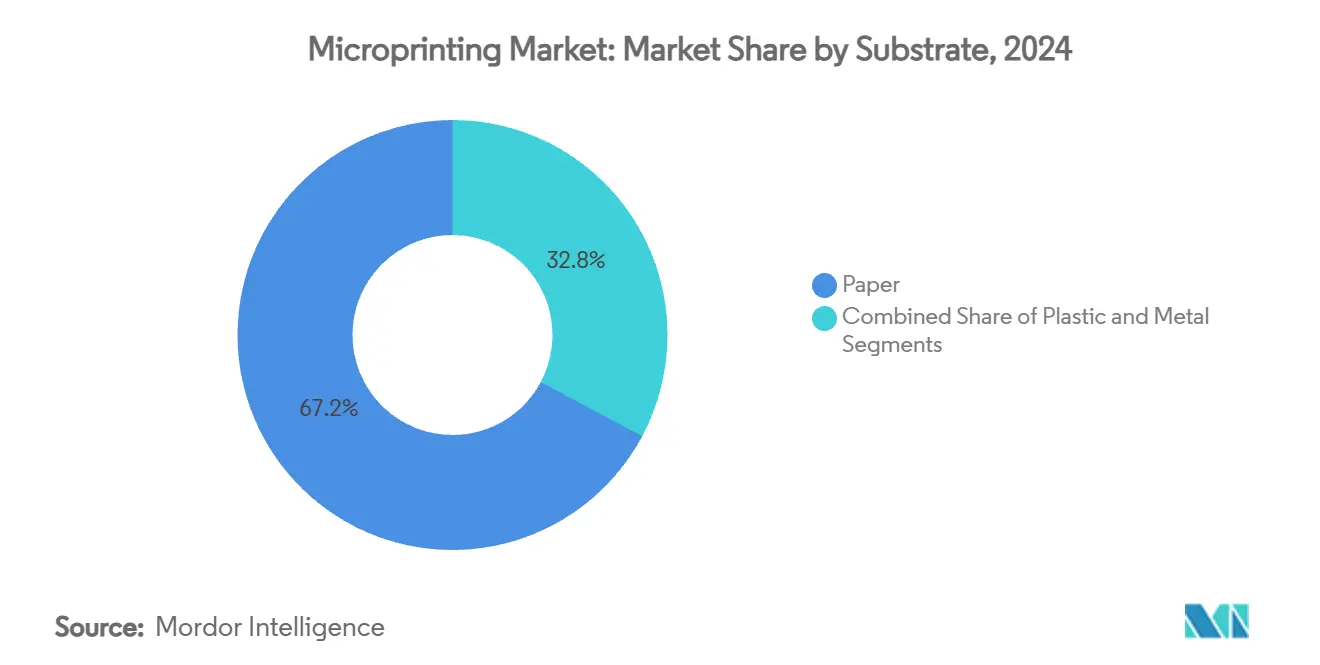
Note: Segment shares of all individual segments available upon report purchase
By Application: BFSI Leadership Faces Pharmaceutical Challenge
The BFSI vertical controlled 37.1% of 2024 revenue owing to mandated MICR lines on cheques and micro-numeric fields in bank drafts. Stringent audit trails and central-bank certifications make switching costs high, entrenching the segment. Yet pharmaceutical packaging is advancing at 4.1% CAGR as global serialisation directives stipulate microprinted random codes at item level. SICPA’s GENESIS line modules now bundle vision inspection with inkjet heads, enabling sub-10 µm lot data that satisfies EU and US track-and-trace.
Government projects remain sizable through e-passport and voter-ID card rollouts. Corporate brand-protection solutions gain traction as luxury houses combat grey-market diversion via blockchain-paired microtext. Transportation and logistics adopt tamper-proof waybills, while the IT-telecom sector embeds micro QR tags on server boards for warranty validation. The widening field ensures the Microprinting market continues to address both legacy cheque volumes and emerging healthcare-driven growth.
Geography Analysis
North America held 35.3% of revenue in 2024 owing to the Drug Supply Chain Security Act’s serialization mandate and enduring MICR standards in banking. The U.S. Homeland Security innovation hub collaborates with domestic press builders to insert micro-security layers that resist photocopying and alter detection. Canada mirrors DSCSA-style rules, while Mexico’s generics industry upgrades blister printing to meet FDA export norms. Ongoing cheque usage, despite mobile options, stabilises demand.
Asia-Pacific posts the highest regional CAGR at 3.8% through 2030. India’s USD 1 billion RFID passport tender, combined with rising e-commerce returns that need secure labels, scales volumes quickly China’s installation of Domino’s N730i digital label press shows converter appetite for 1,200 dpi security engines adapted to domestic compliance needs. Pakistan, Nepal and Indonesia fast-track national identification programmes, each embedding polycarbonate pages with micro-text.
Europe remains significant as the Falsified Medicines Directive and stringent eco-ink laws address counterfeit medicines and sustainability. France’s mineral-oil ban compels ink reformulation, and early-compliant converters gain an edge in tenders. The region’s luxury goods sector further drives colour-shift threads in banknotes. South America and the Middle East invest steadily in e-visa and excise-stamp upgrades, while Africa’s mobile money ecosystem adopts micro-text vouchers to curb agent fraud, indicating new footprints for vendors.
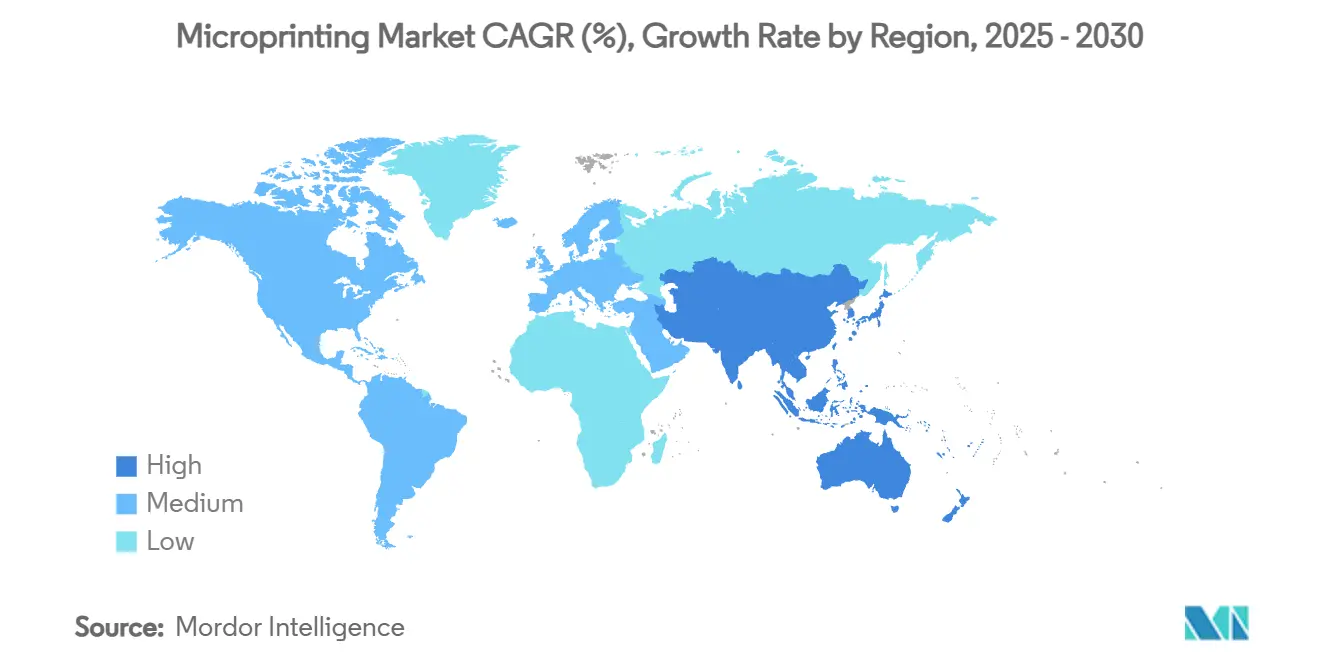
Competitive Landscape
Competition is moderately fragmented. Legacy OEMs such as Canon, Xerox, HP, Heidelberger and Konica Minolta compete with focused security providers including Domino Printing Sciences, SICPA and Giesecke+Devrient. BFSI and central-bank contracts remain concentrated among a handful of certified suppliers due to audit thresholds, but packaging and ID segments are more open to challengers who offer modular inline hybrids. Patent filings in nanoparticle inks and blockchain-anchored verification rise, pointing to capability races rather than pure scale.
Two strategic paths dominate: scale through merger or technology-led product cycles. Xerox’s USD 1.5 billion Lexmark acquisition expands managed print services and cross-sells document security to an enlarged client list. Domino opts for RandD differentiation, unveiling 30% faster CO₂ laser coders and 1,200 dpi engines suited for variable QR coding. Environmental compliance also shapes portfolios; Orion S.A.’s bio-circular black pigment offers a low-VOC alternative that secures European contracts.
Future competition will pivot on integrating edge-devices with cloud authentication. Vendors that bundle handheld scanners, cryptographic key chains and microprinted tags can monetize verification services beyond the substrate. Early movers in AI-assisted inspection systems win productivity gains by slashing false rejects in ultra-fine text.
Microprinting Industry Leaders
-
Zebra Technologies Corporation
-
Canon Finetech Nisca Inc
-
Domino Printing Sciences PLC
-
Xerox Holdings Corporation
-
HP Inc.
- *Disclaimer: Major Players sorted in no particular order
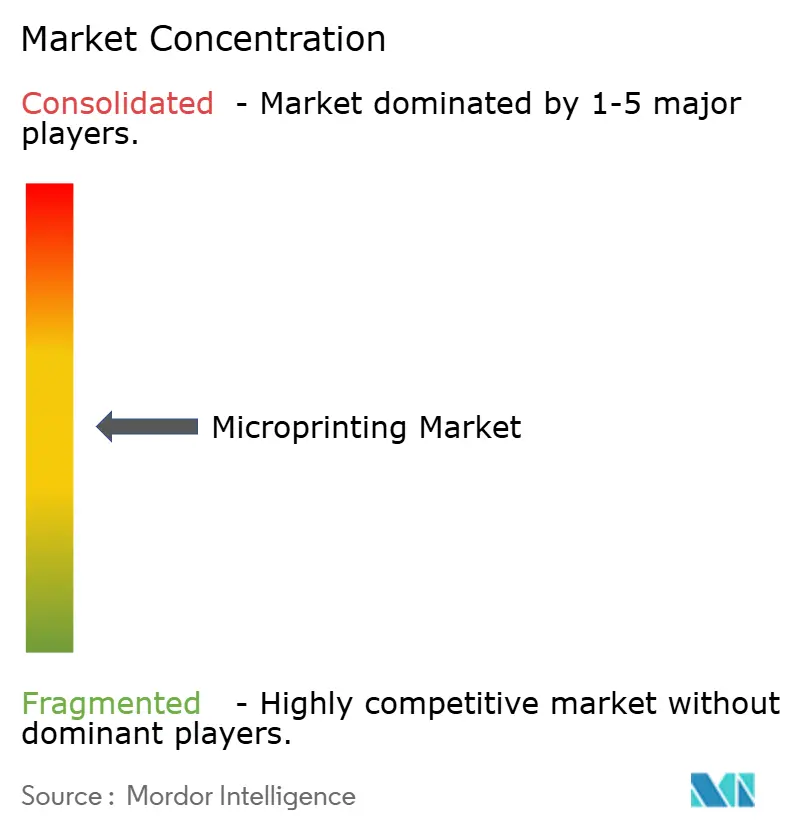


Recent Industry Developments
- January 2025: Xerox closed its USD 1.5 billion purchase of Lexmark International, targeting USD 200 million in cost synergies within two years.
- December 2024: Domino Printing Sciences rolled out the Dx-Series CO₂ laser coders, delivering 30% faster processing at FACHPACK 2024.
- November 2024: Giesecke+Devrient launched the RollingStar Venus micro-mirror security thread for banknotes.
- October 2024: Orion S.A. introduced bio-circular PRINTEX Nature 35 to meet French mineral-oil regulations.
Global Microprinting Market Report Scope
Microprinting creates identifiable patterns or words in a printed medium at a small scale for human vision to read without a magnifying glass. The text may look like a solid line to the unaided eye. Unless the replication method can recognize and duplicate patterns to such scale, attempts to reproduce through photocopy, image scanning, or pantograph often translate as a dotted or solid line. Microprint is mainly utilized as an anti-counterfeiting technology because it can't be easily duplicated using standard digital techniques.
The microprinting market is segmented by type (color and monochrome), by print type (single-sided and double sided), by substrate (paper, plastic, and metal), by application (BFSI, government, corporate, packaging, healthcare, and pharmaceuticals, transportation & logistic) and by geography (North America, Europe, Asia Pacific, Latin America, and Middle East and Africa). The market sizes and forecasts are provided in terms of value (USD) for all the segments mentioned above.
| Color |
| Monochrome |
| Single-Sided |
| Double-Sided |
| Paper |
| Plastic |
| Metal |
| BFSI |
| Government |
| Corporate |
| Packaging |
| Healthcare and Pharmaceuticals |
| Transportation and Logistics |
| IT and Telecom |
| North America | United States | |
| Canada | ||
| Mexico | ||
| South America | Brazil | |
| Argentina | ||
| Rest of South America | ||
| Europe | Germany | |
| United Kingdom | ||
| France | ||
| Italy | ||
| Spain | ||
| Rest of Europe | ||
| Asia-Pacific | China | |
| Japan | ||
| South Korea | ||
| India | ||
| Indonesia | ||
| Australia | ||
| Rest of Asia-Pacific | ||
| Middle East and Africa | Middle East | UAE |
| Saudi Arabia | ||
| Turkey | ||
| Rest of Middle East | ||
| Africa | South Africa | |
| Egypt | ||
| Rest of Africa | ||
| By Type | Color | ||
| Monochrome | |||
| By Print Type | Single-Sided | ||
| Double-Sided | |||
| By Substrate | Paper | ||
| Plastic | |||
| Metal | |||
| By Application | BFSI | ||
| Government | |||
| Corporate | |||
| Packaging | |||
| Healthcare and Pharmaceuticals | |||
| Transportation and Logistics | |||
| IT and Telecom | |||
| By Geography | North America | United States | |
| Canada | |||
| Mexico | |||
| South America | Brazil | ||
| Argentina | |||
| Rest of South America | |||
| Europe | Germany | ||
| United Kingdom | |||
| France | |||
| Italy | |||
| Spain | |||
| Rest of Europe | |||
| Asia-Pacific | China | ||
| Japan | |||
| South Korea | |||
| India | |||
| Indonesia | |||
| Australia | |||
| Rest of Asia-Pacific | |||
| Middle East and Africa | Middle East | UAE | |
| Saudi Arabia | |||
| Turkey | |||
| Rest of Middle East | |||
| Africa | South Africa | ||
| Egypt | |||
| Rest of Africa | |||


Key Questions Answered in the Report
What is the current value of the microprinting market?
The microprinting market is valued at USD 623.24 million in 2025 and is forecast to rise to USD 712.40 million by 2030.
Which region leads the microprinting market?
North America leads with 35.3% share in 2024, primarily due to strict banking and pharmaceutical regulations.
Which segment is growing fastest within the microprinting market?
Pharmaceutical packaging is the fastest-growing application segment, projected at a 4.1% CAGR through 2030, driven by global serialization mandates.
How are environmental regulations affecting microprinting?
Regulations such as France’s mineral-oil ban are pushing ink makers toward bio-circular and low-VOC formulations, increasing RandD costs but opening opportunities for compliant products.
Page last updated on:
